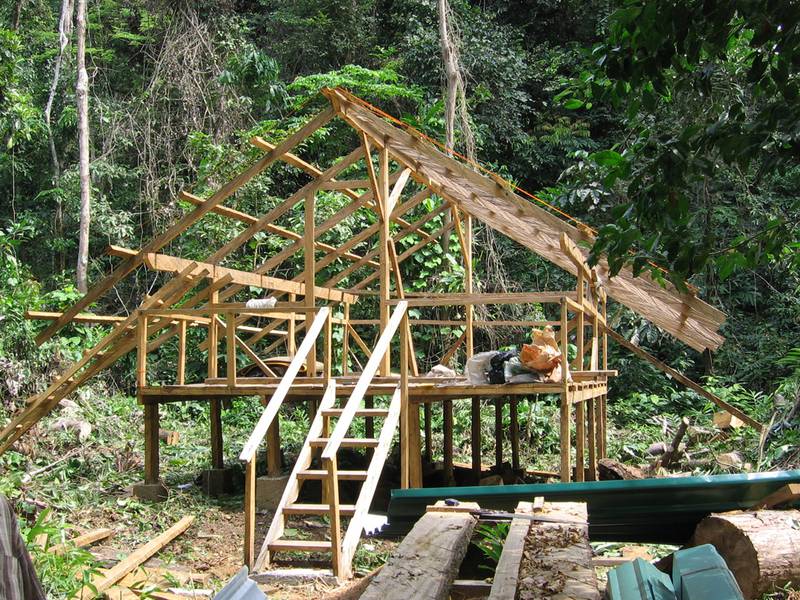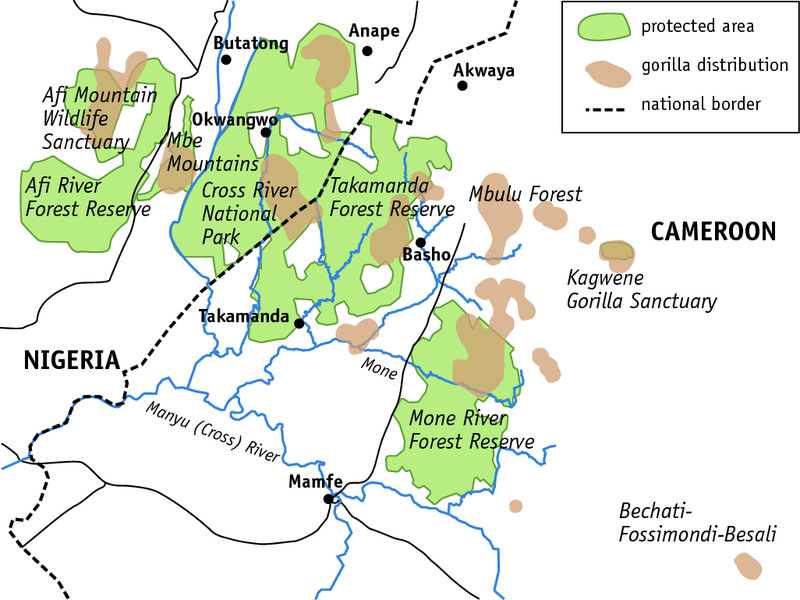Nigeria: Cross River Gorillas
Categories: Journal no. 38, Protective Measures, Nigeria, Afi, Mbe, Cross River Gorilla, Gorilla Journal
Improving Gorilla Protection in the Mbe MountainsCovering an area of about 80 km² the Mbe Mountains is one of three sites in Nigeria where gorillas are known to occur. Mbe is located midway between the Afi Mountain Wildlife Sanctuary to the west and Cross River National Park (Okwangwo Division) to the east. Since 2006 the area has been managed as a community wildlife sanctuary by the Conservation Association of the Mbe Mountains (CAMM) with support from the Wildlife Conservation Society (WCS) and the local NGO Development in Nigeria (DIN). Funds to support Mbe have been provided by a variety of organizations including the Great Ape Conservation Fund of the United States Fish and Wildlife Service, the Great Ape Trust of Iowa, the Kolmården Fundraising Foundation, the Margot Marsh Biodiversity Foundation, North Carolina Zoo, Berggorilla & Regenwald Direkthilfe and the Ecosystem Grants Programme of IUCN-Netherlands.
Although protection efforts in the Mbe Mountains have been fairly successful to date, the lack of a clear boundary on the ground posed a major challenge to law enforcement. In 2006 CAMM and its partner organizations agreed to demarcate a boundary for the conservation area. Working with the nine surrounding communities and the Cross River State Forestry Commission (the government institution in charge of all forests and wildlife within Cross River State), WCS helped to demarcate a provisional boundary - a map of this provisional boundary was subsequently signed by the traditional rulers of all nine communities in 2007. The boundary included two critical corridor areas linking Mbe to Cross River National Park and to the Afi River Forest Reserve. Unfortunately permanent demarcation of this boundary was delayed owing to the lack of funds.
In 2008, WCS received grants from the Kolmården Fundraising Foundation and from IUCN-NL (through DIN) to complete the permanent demarcation of the boundary. The process is now almost complete and soon the sanctuary will have a clearly demarcated boundary (all vegetation cleared in a 3-m-wide strip and planted with seedlings of bush mango and teak together with concrete boundary beacons). It is expected that this boundary will be endorsed by Cross River State Forestry Commission and will have full legal status. This will eliminate the difficulty faced by eco-guards when dealing with offenders who feign ignorance of the boundary between the community use area and the sanctuary as an excuse to carry out illegal activities in the area.
Constructing a Second Research Camp in the Mbe Mountains
With funds provided by Berggorilla & Regenwald Direkthilfe in 2008 WCS are currently constructing a second research camp in the Mbe Mountains. Located in the very heart of the sanctuary the first camp was completed in 2006 - also with funds from B&RD. The first camp has greatly facilitated research and gorilla monitoring in the area and also acted as a base for anti-poaching patrols by Mbe's 9 eco-guards. The second research camp is located in the southern sector of the mountains - an area that is difficult to reach from the first camp. As with the first camp, construction of the second camp has taken longer than expected because of the difficult terrain - and all building materials had to be conveyed to the site by porters. Construction of the camp is however almost complete. Built entirely with local labour construction of the camp is providing valuable, even though temporary, employment opportunities besides giving the people a sense of ownership of the facility that should encourage care for and protection of the camp.
Gorilla Monitoring with Cyber-tracker Technology
As part of our ongoing efforts to improve gorilla monitoring we have recently introduced the use of a hand-held computer-based data capture system in the Mbe Mountains and Cross River National Park. Based on the Cybertracker software these units allow the collection of standardized, georeferenced data by monitoring teams in the field. Ten units were provided for use in Nigeria by the North Carolina Zoo with a grant from the Great Ape Conservation Fund of the US Fish and Wildlife Service. Training was conducted by Richard Bergl of North Carolina Zoo and took place in August 2008 (in the Mbe Mountains, Nigeria) and January 2009 (at the Kagwene Gorilla Sanctuary, Cameroon). The training included practical demonstrations of how the hand-held units work, data collection practice as well as practical computer-based training on use of the Cybertracker software. Researchers in both Cameroon and Nigeria are already using the equipment to collect and analyse data. By using this technology we hope to be able to improve the quality of the data that our eco-guards collect in the field, improve our database management and the effectiveness of our conservation efforts.
Gorilla Census of the Afi Mountain Wildlife Sanctuary
Working with the Cross River State Forestry Commission and Pandrillus, WCS participated in a joint survey of the Afi Mountain Wildlife Sanctuary in March 2009. The survey was conducted to evaluate the status of three primate species of conservation importance - the Cross River gorilla Gorilla gorilla diehli, the Nigeria-Cameroon chimpanzee Pan troglodytes ellioti and the drill Mandrillus leucophaeus. The sanctuary was divided into 9 sectors and each sector simultaneously searched by a team of 3 observers.
The 7-day sweep survey found evidence of the presence of all three species though evidence of gorillas was observed only in the south-central, southern and north-eastern areas of the sanctuary. Fresh evidence of gorillas was also observed outside of the sanctuary in the adjacent Olum Hills. Gorillas previously abandoned the Olum Hills in 1997 when the area was destroyed by fire but subsequently returned to the area in 2005.
In February 2008 Afi Mountain Wildlife Sanctuary suffered from another series of major wild fires. Originally started in nearby farms the fires quickly spread to the north-central and south-eastern sectors of the sanctuary where extensive damage was caused. No gorilla sign was observed in the affected areas during the March 2009 survey. A full report on this survey will be provided in the next Gorilla Journal.
Inaoyom Imong and Andrew Dunn


